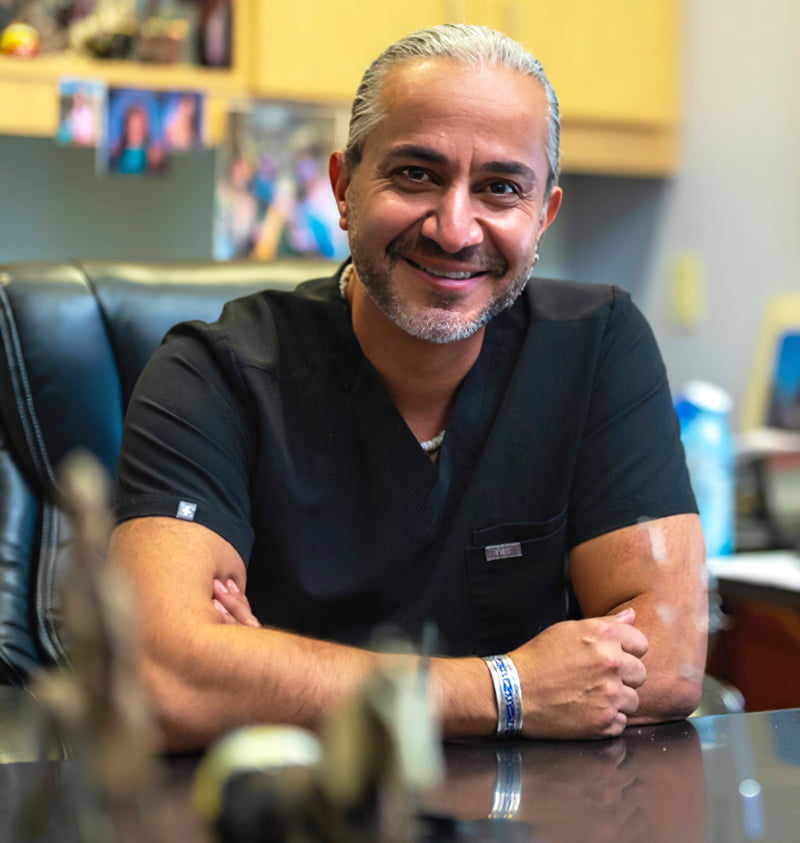
Dr. Reza Khazaie, DDS, Prosthodontist
The Complete Guide to Dental Crowns
We hope you find this guide on dental crowns to be informative and helpful. You will not find this content anywhere else on the internet. It is the content and experiences of Dr. Reza Khazaie, DDS, Prosthodontist and founder of Willow Pass Dental Care, a leader in cosmetic dentistry and world-renowned Prosthodontist in Concord, CA.
Dr. Reza Khazaie is highly regarded amongst his patients and peers as the smile expert.
Dr. Khazaie is an expert in the specialized treatment of dental and facial problems involving restoring missing teeth and jaw structures. He is a highly trained specialist in cosmetic dentistry, dental implants such as the All On 4 dental implants, bridges, dentures, digital dentures, implant supported dentures, dental crowns, dental veneers, TMJ/TMD, and many more dental procedures.
So if you’re looking to learn as much as you can about dental crowns, I believe you will find value in this guide.
So let’s get started.

When You May Need A Dental Crown
Did you know?
“dental crowns near me”
“Concord dental crowns”
“dental crowns Concord”
Did you know there are over 43,000 searches each month from people searching “dental crown” to find a website like Willow Pass Dental Care?
That’s a lot of searches for dental crowns!
Maybe you didn’t find us by searching “dental crown,” “dental crowns,” or “dental crown near me,” regardless, we are so glad you are here.
Google shows over 103,000 searches a month in the United States for related keywords around dental veneers.
In our own neighborhood of Concord, there are over 30 searches a month for those searching dental crowns Concord, dental crown Concord, dental crowns near me, dental crowns cost, and more!
The interest in dental crowns over the last 15+ years is near an all-time high. Just see the graph from Google Trends below:
Our goal is to help you find the information you need to make an informed decision about dental crowns and other tooth replacement or tooth restoration options. I hope you will find what you are looking for in our Comprehensive Guide to Dental Crowns.
If you have any questions, please don’t hesitate to ask by sending Dr. Reza an email at contactus@willowpassdentalcare.com, and my team or I will get back to you. Make sure to put in the subject line: Dental Crown or Dental Crowns.



Benefits of Dental Crowns
Dental crowns offer a versatile aesthetic and functional solution that you can employ to address both aesthetic and practical concerns.
Some restorative techniques, such as porcelain veneers and dental bonding, may not have the adequate longevity a patient requires. Other procedures may be too invasive, too time-consuming, or simply too expensive.
Dental crown procedures offer a middle ground for patients looking to repair a severely damaged tooth without resorting to total tooth extraction and still retaining functionality. Better yet, dental crowns can last a very long time. Many patients, barring extreme circumstances, will never need to replace their crowns during their lifetime. Many dental crowns will last decades despite daily wear and tear with good dental hygiene and care.
Most dental crowns are warranted by the manufacturers for 10 years or more.
As with many restorative dental procedures, longevity will vary from patient to patient depending on a broad range of factors, including natural bite, preexisting conditions, the quality of the materials chosen, the manufacturer, and the experience of the dentist operating. This is something Dr. Reza Khazaie and the team at Willow Pass Dental Care will address in your consultation to provide you with the best solution based on your pre-existing conditions and dental goals.
Why dental crowns?
Dental crown procedures are the mainstay of most restorative dental practices in the world. The ability to cap and completely cover a tooth for health and aesthetic purposes while still providing a high degree of functional strength and resilience is beneficial. To this end, dental crowns are most often employed to provide permanent reinforcement and protection for damaged and decayed teeth.
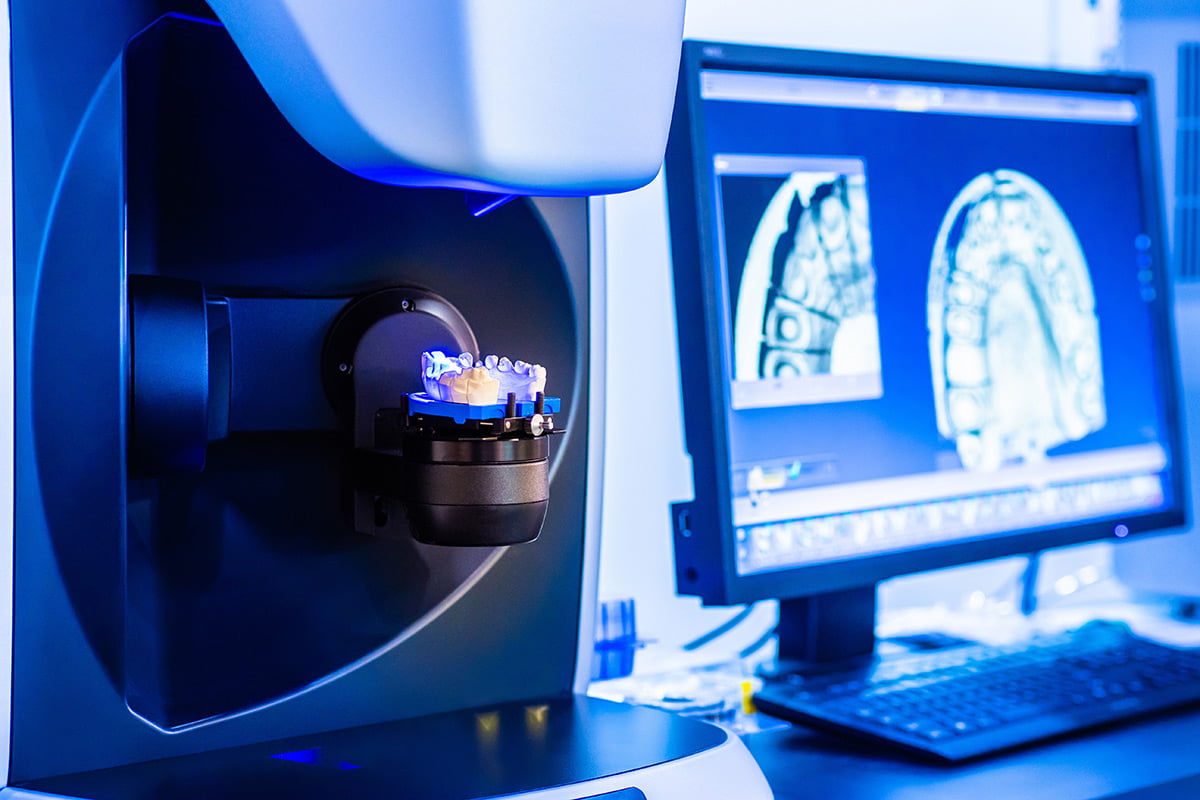
Teeth with large cavities, extensive fillings, cracks, fractures, and other forms of physical damage that severely weaken their structural integrity are good candidates for dental crowns.
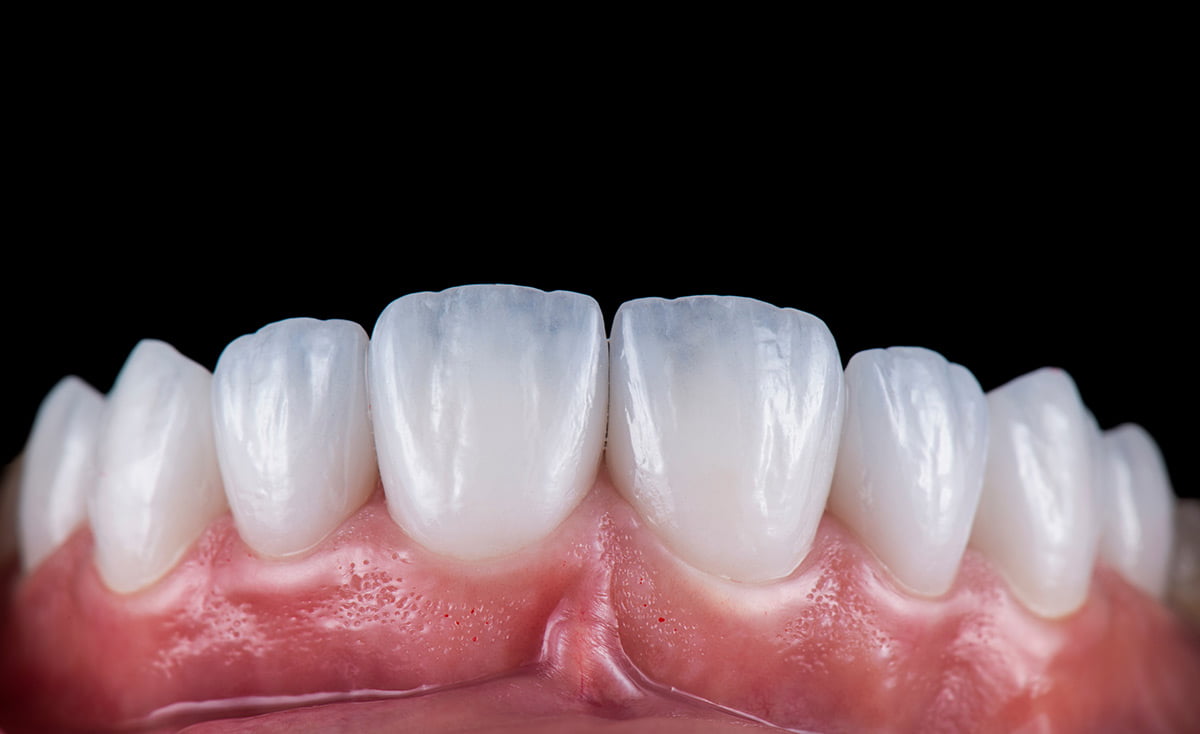
However, damage may not be the only consideration to getting a dental crown. Aesthetic considerations may also be a concern for a dental crown procedure.
Some patients may not be suitable candidates for partially retentive restorative procedures, such as dental bonding treatments, for various reasons.
Bruxers, or patients who suffer from teeth grinding and jaw clenching disorders, may require more resilient crowns for restorative treatments to combat the stress their conditions place on their teeth.
Likewise, many patients will find that less durable solutions won’t hold up over time due to the high bite forces exerted on certain parts of the mouth.
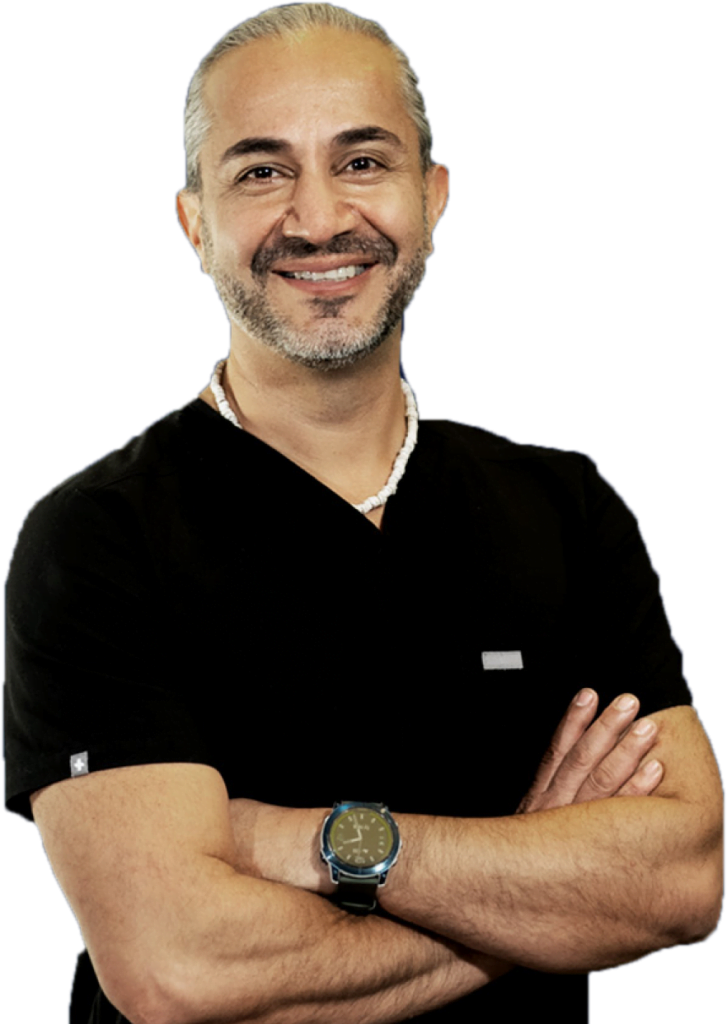
Dr. Reza’s Guarantee
Watch Dr. Reza Video
“I guarantee you I will give you the best care available. I will restore your mouth and your teeth to their highest potential.”
4 Types of dental crowns
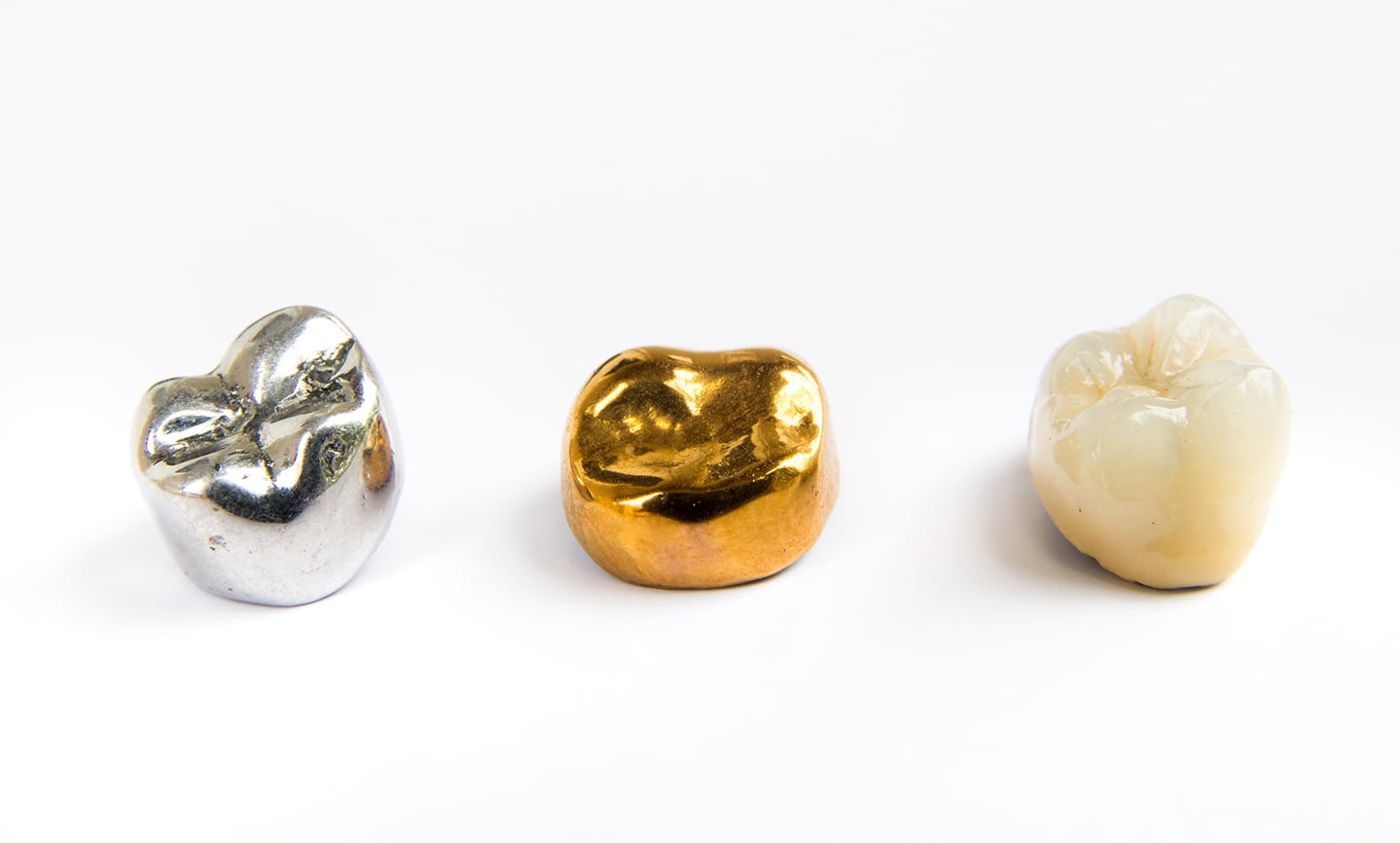
Dental crowns are one of the most popular dental prosthetics used today, with millions of people worldwide receiving dental crowns every year to replace, repair, or reinforce missing or damaged teeth. People have been placing crowns over their teeth for thousands of years. Ancient and pre-modern people used all kinds of crowns, including crowns made from gold, wood, and animal ivory.
Today, there are four primary types of dental crowns that you can get at your dentist or prosthodontist’s office. These include dental crowns made from porcelain (all-ceramic), metals, porcelain fused to metal, and resin.
Let’s explore each type of dental crown in more depth.
1. Porcelain Crowns (All-Ceramic)
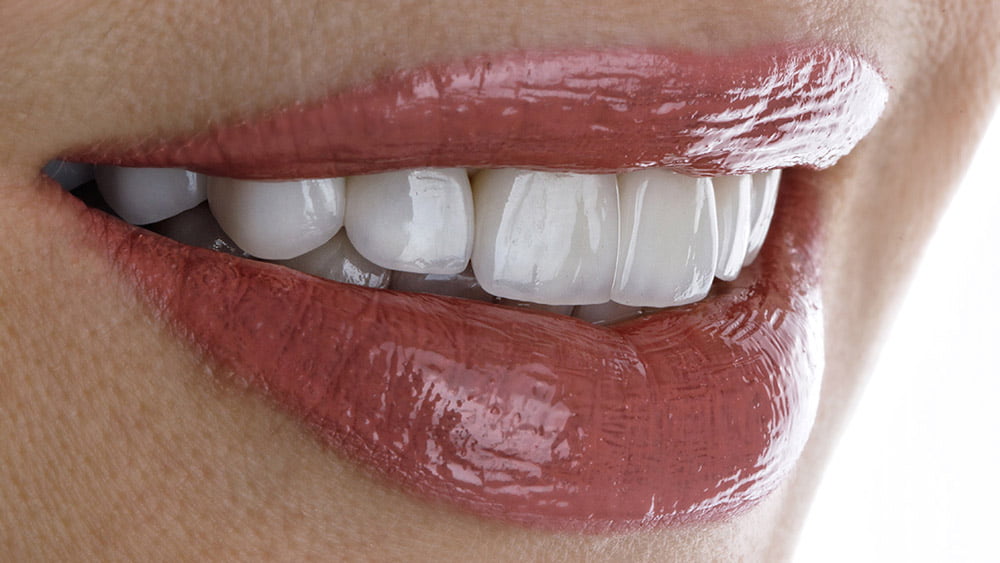
Strengths
Porcelain crowns have stunning natural aesthetics, seamless visual transition, and non-allergenic.
Weaknesses
Porcelain crowns are more expensive and can break more easily than metal options, you must remove more enamel to accommodate ceramic crowns.
Porcelain or all-ceramic crowns are hands down the best solution for those looking for unmatched aesthetic qualities. Porcelain looks like natural teeth and has surface translucency properties, and shines much as natural teeth do.
They can be color-matched accurately and precisely to your existing teeth, making them the perfect solution for patients who value a stealthy approach to cosmetic dentistry. Many dental professionals, let alone a casual observer, will have difficulty telling a properly crafted and fitted porcelain crown from a natural tooth.
Ceramic materials also come with other very functional qualities beyond aesthetics. For one, ceramic is a highly durable material resistant to compression forces (such as those exhibited during chewing and biting). In addition, its naturally stain-resistant surface also resists bacteria and other undesirable microbes, preventing them from forming dental plaque.
However, the unparalleled aesthetic and functional qualities of a porcelain crown come with certain costs.
All-ceramic crowns are typically the most expensive option available today. Furthermore, while the rigidity of ceramic is excellent for dealing with compressive forces, it can become a liability when exposed to shear and diagonal forces.
All-ceramic crowns are typically the most expensive option available today.
— Dr. Reza Khazaie, DDS, Prosthodontist
Unlike metals and other ductile materials, ceramic will hold its rigid shape until a great force causes it to shatter. This brittleness can be a problem for the mouth since the mouth doesn’t only move up and down.
People who play contact sports or have an unusual bite should recognize that while durable, porcelain teeth are still brittle and may break when exposed to unexpected lateral forces.
2. Metal Crowns
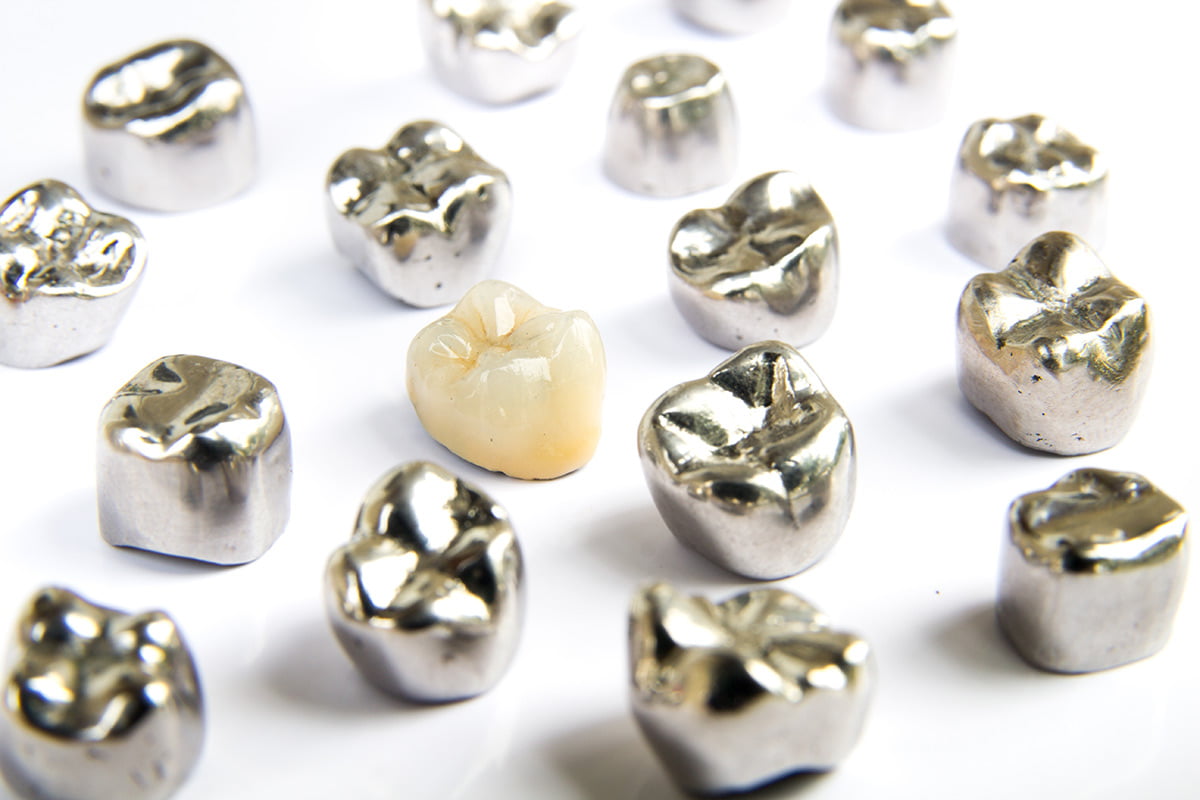
Strengths
Metal crowns provide a strong aesthetic statement, best long-term durability, economical, and less removal of existing enamel.
Weaknesses
Metal crowns may cause an allergic reaction in patients sensitive to certain metals.
Metal crowns are a classic solution that has been in use for centuries. From Etruscan kings to 18th-century pirates to modern-day celebrities, metal teeth have been in fashion in one form or another for a very long time.
Metal dental crowns can be cast or made from a variety of metal alloys. The most popular among these alloys include gold alloys, nickel alloys, and chromium-infused metal alloys.
Besides bringing a real shine to your mouth, metal crowns have several essential benefits that patients should consider. First and foremost, metal crowns last the longest and exhibit a higher lifespan than any other dental crown material. While metal is not harder than porcelain, its ductility gives it far superior lateral strength, allowing for flexing without breakage.
In contrast, a porcelain crown exposed to unexpected lateral forces might shatter. Furthermore, base metal alloys are typically much cheaper than porcelain teeth.
While gold, silver, and other precious metals will certainly command a premium, they also come with all the strengths of a dental-grade metal solution, including ductility and toughness.
Gold, in particular, is valued as a crown material for its inert nature and natural beauty. So if you want to make a statement with your new teeth, some people go with gold.
Unfortunately, metals have also been shown to trigger an allergic reaction in a tiny minority of patients receiving a dental crown. More and more patients are asking for metal-free dental applications due to the concern about the potentially toxic effects of metals in a person’s oral cavity. While many studies have shown the long-term safety of common dental-grade metals, such as nickel alloys, metal sensitivity remains a concern for some.
If you’re concerned about how metal crowns may affect your health, consider opting for inert gold crowns or the #1 option, all-ceramic porcelain crowns.
3. Porcelain Fused Metal Crowns
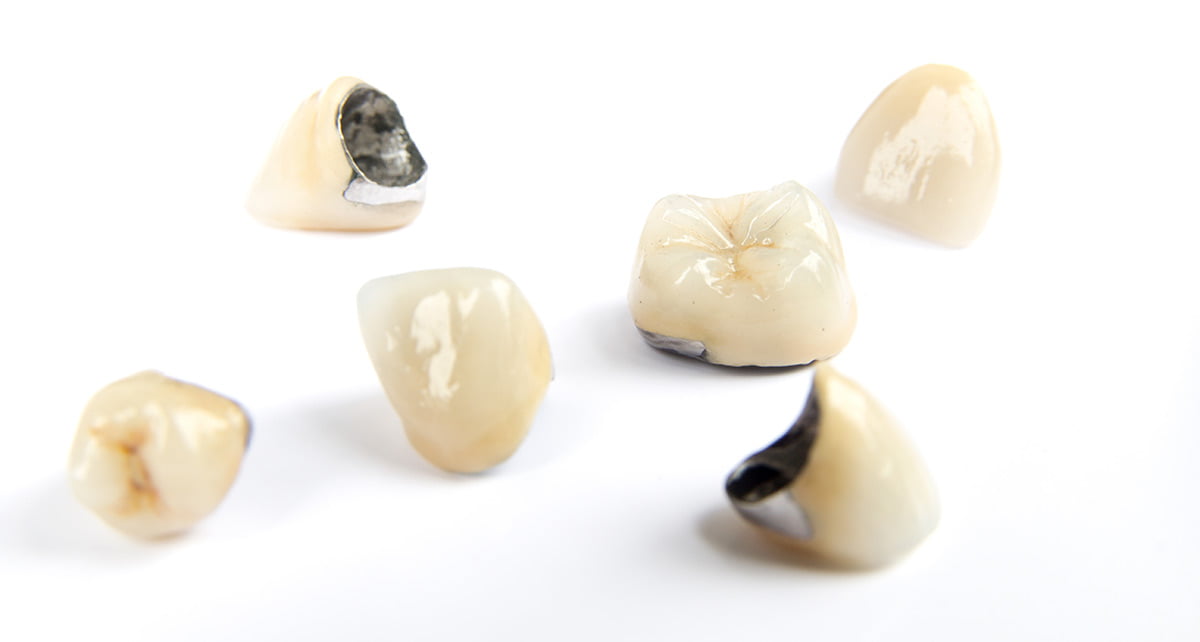
Strengths
All the compressive strength of porcelain combined with the ductility of metal.
Weaknesses
More expensive, a metal band is visible and can detract from overall aesthetics.
Porcelain fused to metal crowns are the dental industry’s attempt to solve the weaknesses of both porcelain (all-ceramic) dental crowns and metal alloy dental crowns by merging the two materials.
With porcelain fused to a metal solution, an inner layer of dental-grade metal alloy combined with an outer layer of porcelain. This gives the overall dental crown a better fit, higher ductility, and the ability to color match like conventional ceramic teeth.
Other benefits of ceramic, including stain-resistance and life-like appearance, also carry through to porcelain fused to metal crowns.
However, porcelain fused to metal crowns is still prone to breakage.
The underlying layer of metal is often visible at the base of the crown. This darker metal layer can create a visually distracting band at the base of your teeth leading some to find the aesthetic qualities less than desirable.
For patients who opt to go this route, there are a few things a prosthodontist can do to lessen the visual impact of the metal band, including covering the base with gingival material.
4. Resin Crowns
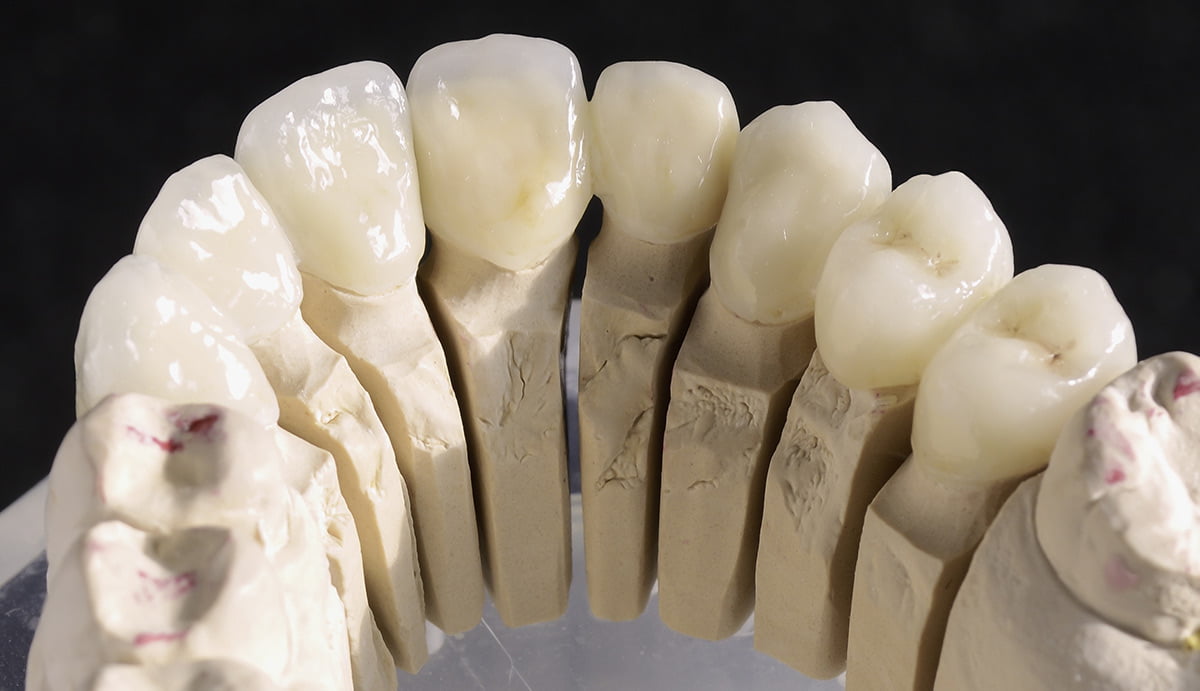
Strengths
Inexpensive, easily fabricated and replaced.
Weaknesses
Extremely weak, not recommended for long-term usage.
While resin crowns are common, they are almost always used temporarily and are very rarely used for permanent crowns.
This is for many reasons.
First, the resin is weak. Resin crowns can rapidly wear down and be prone to breakage. As a result, most prosthodontists only use resin crowns as a temporary while a permanent crown is fabricated. For this purpose, the resin is an excellent choice as it is cheap to make and easily replaced. That’s just as well since resin crowns usually don’t look very good either.
While resin in other prosthetic applications can be made to look quite realistic and life-like, when used as a dental crown material, the effort expended to craft a quality resin crown isn’t worth it. Therefore, we do not recommend the use of resin crowns.
Mahin
Full Mouth Reconstruction
Dr. Khazaie restored Mahin’s lovely smile with an
implant and a full mouth reconstruction.
Dental Crowns Concord CA
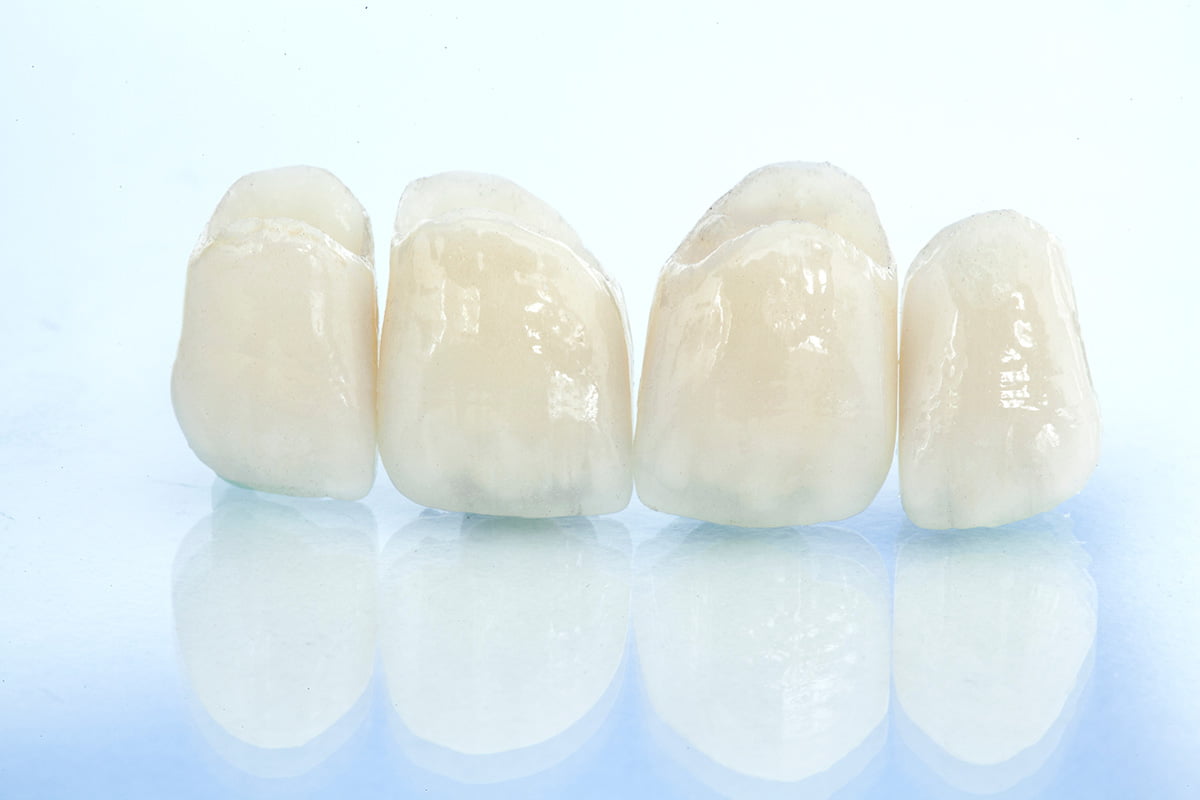
While a dental crown procedure is simple in concept, the actual preparation is quite involved.
Here are a few reasons:
Dental Crown Preparation

The preparation of a tooth before receiving a dental crown can be divided into the following four steps:
Decay removal and dental build-up may be additional steps but are not necessary during a dental crown procedure.
A patient with a cracked tooth with no decay, for example, will more than likely skip the first and second steps.
1. Anesthesia
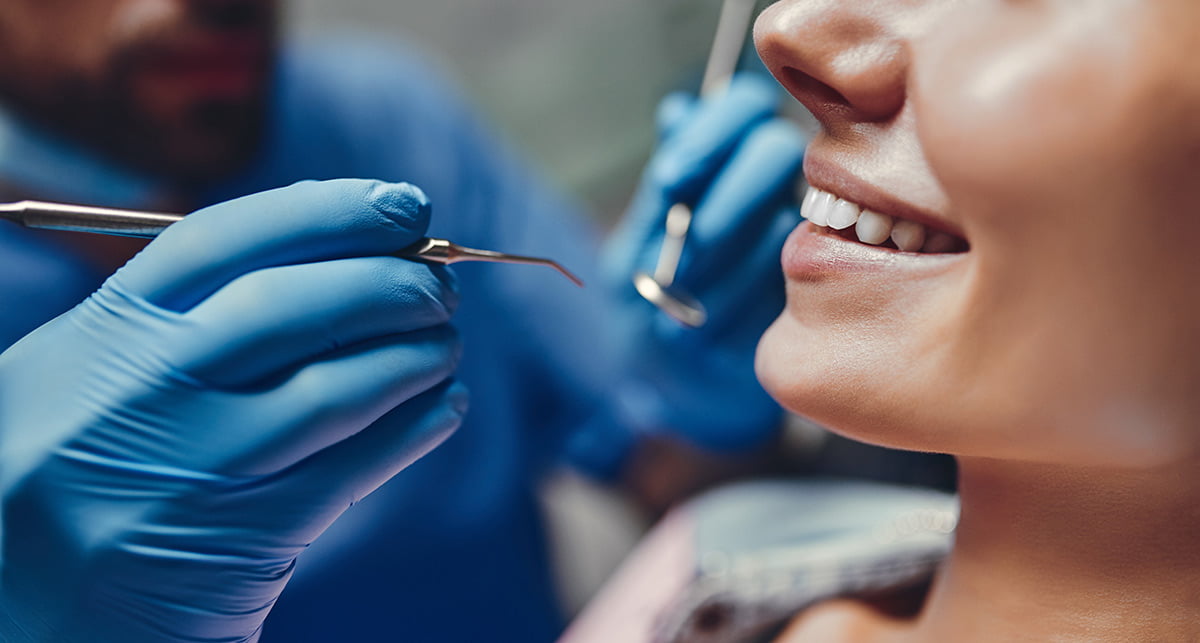
Pain is often a concern for patients when undergoing a dental procedure. The preparation of a tooth itself, however, should be painless.
Dentists will employ local anesthesia to numb the tooth and the soft tissues around the tooth, rendering them unable to feel pain. So, while you may still feel pressure, you won’t feel any pain whatsoever during the preparation of the tooth.
2. Dental trim
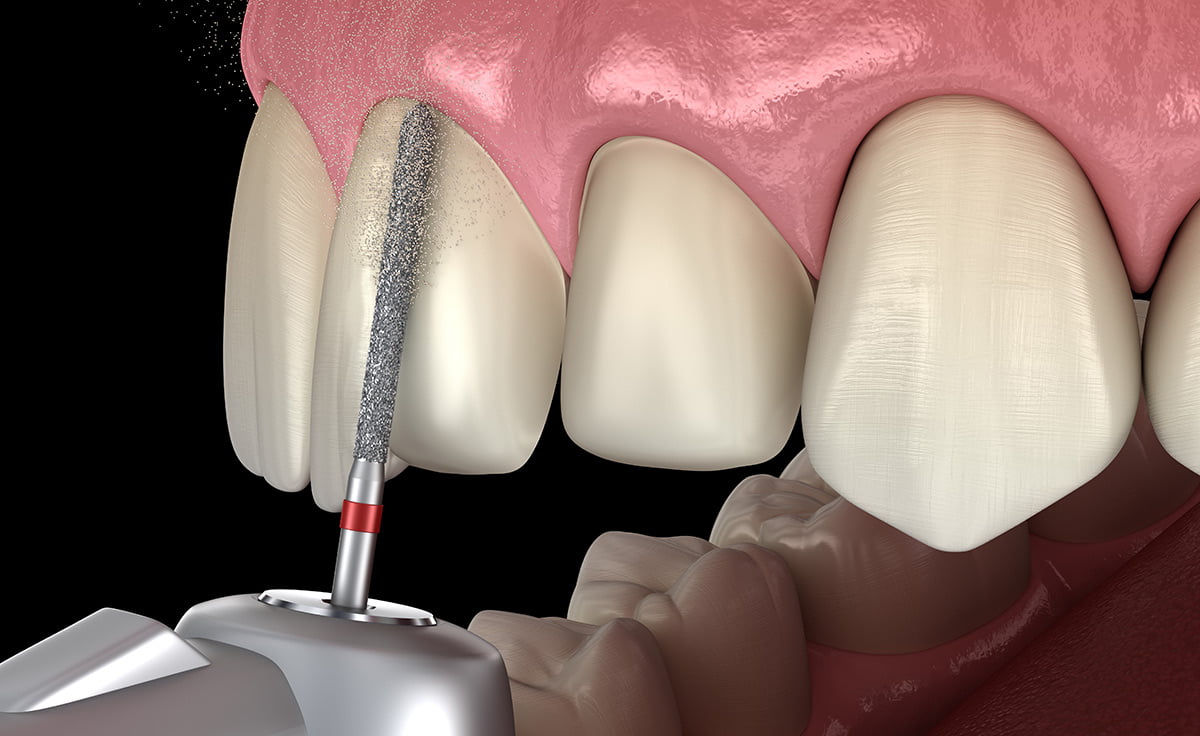
During the trimming and shaping process, the existing tooth is meticulously shaped by a diamond-coated dental drill.
Next, the dentist will carefully trim away the appropriate amount of enamel to accommodate the desired crown. The amount of dental material that will be trimmed depends on the material the crown is composed of.
All ceramic crowns, which are thicker, require more material to be removed. Typically, patients can expect about 2mm of the outer surface of their teeth to be trimmed away. Meanwhile, metal crowns require much less removal of existing enamel.
Patients opting for metal crowns, such as gold or silver, can expect about 1.5mm of material to be removed.
During the dental trimming process, the dentist will also leave a clear termination point and 0.5mm border between the trimmed area and the gums. This is where the dental crown will end visually, and the existing teeth will begin.
3. Finishing preparation
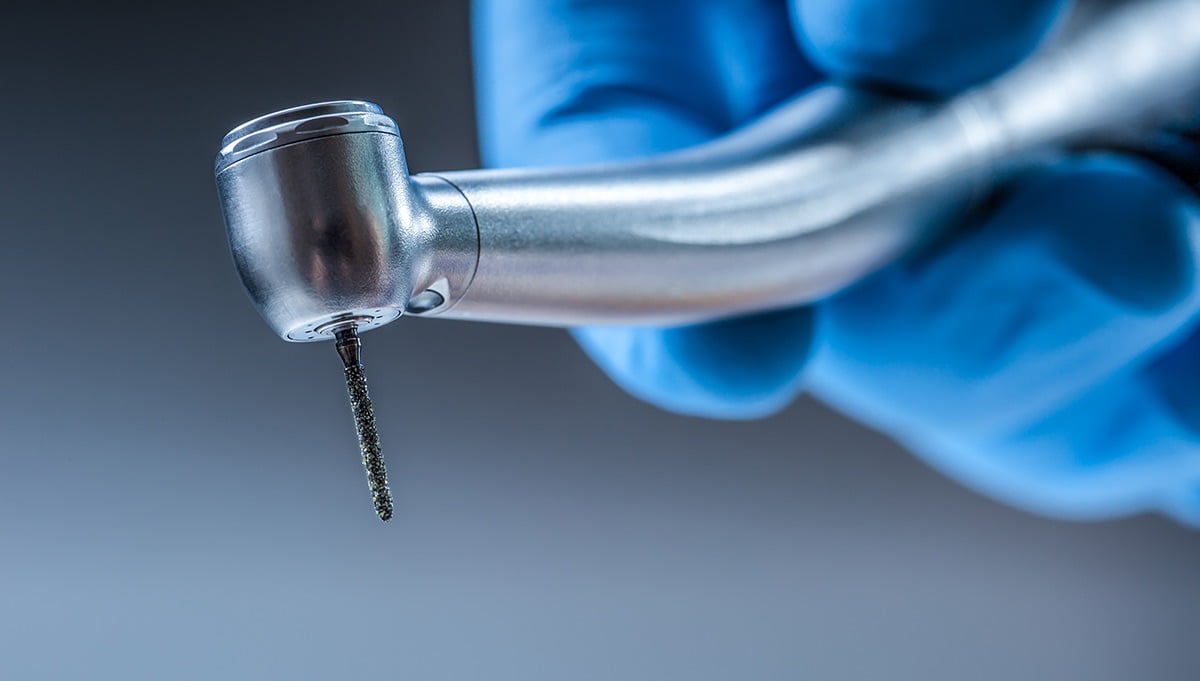
Once the primary trim is complete, it’s time to finish the preparation.
The dentist will employ a fine-grit dental bur to smooth the trimmed tooth and remove any surface irregularities and sharp edges. This will allow for a better fit for the final crown and overall better aesthetics.
4. Impression taking
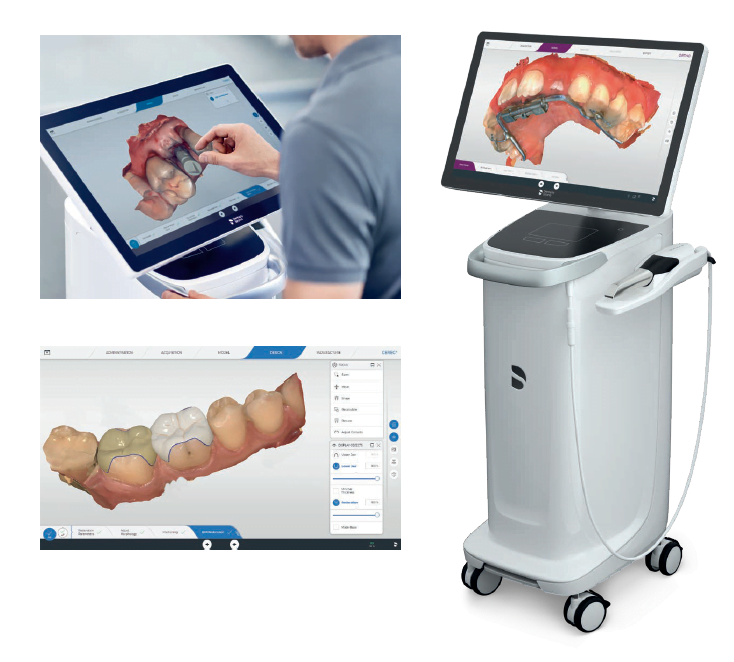
Finally, with the target tooth trimmed and finished, there’s just one step left before placing a temporary or permanent dental crown. First, a final physical or digital dental impression is taken, which will then be sent to a fabricator to be made.
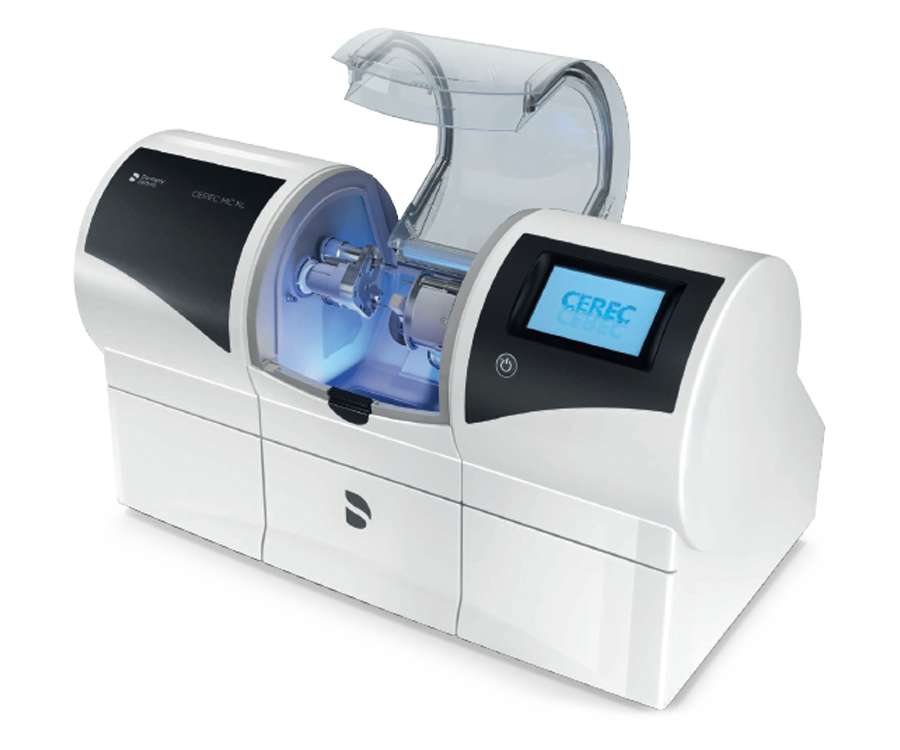
Some high-end dental clinics like Willow Pass Dental Care have the necessary CAD/CAD technology and manufacturing equipment to perform in-house fabrication. As a result, these clinics often offer what are known as “same-day” or even “1-hour” crowns.
Chelsea’s Story
Watch Video – Part One
Watch Video – Part Two
Crowns, Partial Crowns, Onlays, and Inlays
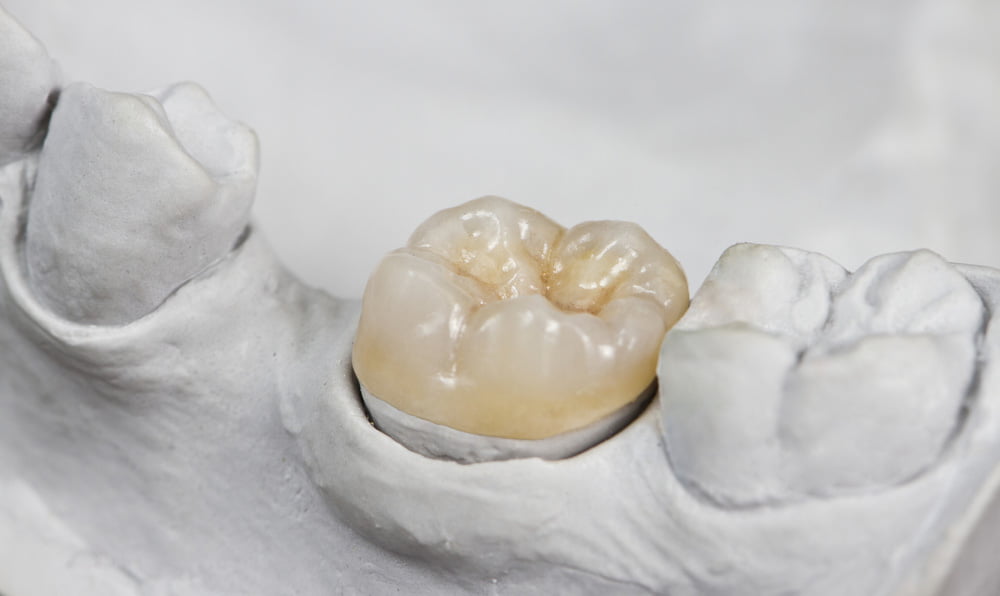
Dentists will turn to dental crowns when damage to a tooth is too extensive for a direct filling to repair. However, the problem is when some dental crowns don’t cover your entire tooth.
While full dental crowns are popular and often necessary to salvage a severely damaged tooth, other choices include partial dental crowns or indirect fillings.
Indirect fillings, or partial dental crowns, are a critical variation on full dental crowns.
Partial Crowns (indirect fillings)
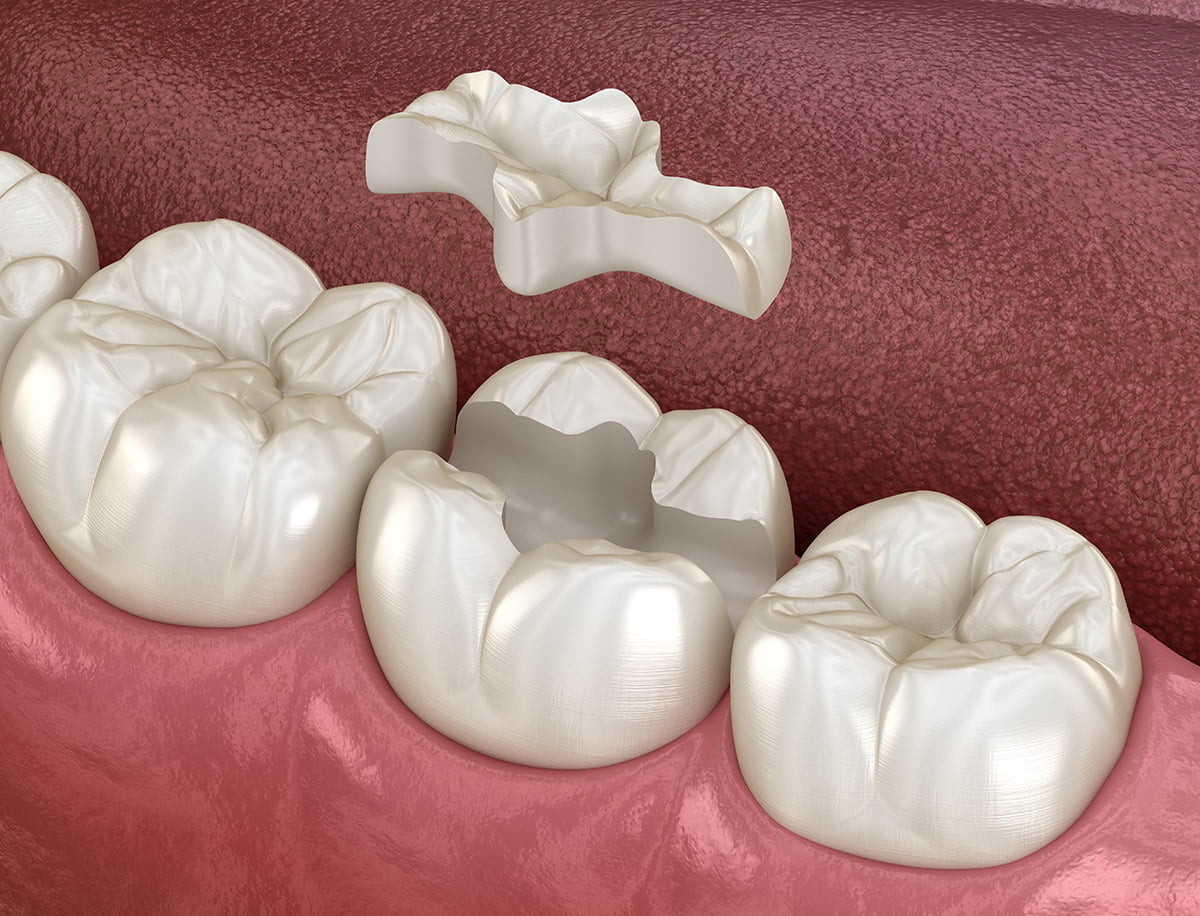
As the name suggests, partial dental crowns are dental crowns that only cover a part of your tooth.
Partial dental crowns come in various shapes and sizes, from small inlays that are more like large fillings to extensive onlays that may cover three-fourths of your tooth. The latter is often referred to as a ¾ dental crown).
Partial crowns cover every type of crown that is not what is referred to as a full dental crown. This can be confusing for patients since many dental clinics use the general term “partial crown” and more specific terms such as “inlays” and “onlays” somewhat interchangeably. Furthermore, terms such as ¾ crowns only muddy the waters further.
To keep things simple and to help you understand the differences, it is essential to remember the following:
Inlays vs. Onlays
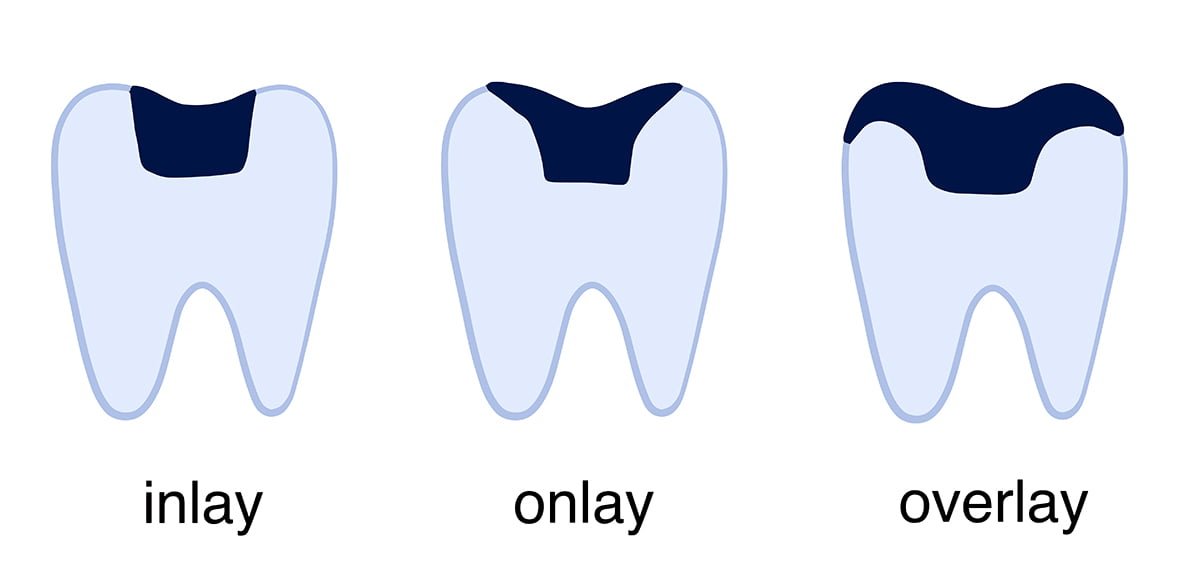
Both inlays and onlays are popular types of partial crowns. Like a conventional full crown, both inlays and onlays are used to cover, protect, and reinforce parts of a tooth. The primary difference is in how they are deployed.
Inlays are often used when a cavity is too large for a simple filling to fix. Inlays will also rarely cover the cusps or sharp pointy parts of your tooth.
An onlay, on the other hand, will often cover parts of the cusp. Both inlays and onlays are fabricated as a single piece placed in or on a tooth. Because inlays and onlays are fabricated outside of the mouth then put in place, they are often referred to as indirect restorations. In comparison, a typical dental filling is built up in the mouth and is a direct restoration.
Inlays are used when a simple filling is not enough to repair damage to a tooth due to dental caries or a tooth fracture. Inlays possess several significant advantages over simple amalgam or resin fillings.
Because inlays are fabricated offsite, they do not experience shrinkage. Furthermore, remote fabrication means that there is virtually no limit to the materials that can be employed. As a result, inlays can be made from everything from metal to porcelain ceramic.
In comparison, direct fillings often experience shrinkage when it hardens in a patient’s mouth and is limited to materials that you can rapidly cure in-situ. While much more expensive than a simple dental filling, dental inlays still have important advantages, including superior resistance to occlusal forces, resilience, aesthetics, and ease of maintenance.
Onlays are also fabricated outside of a patient’s mouth, offering many of the same benefits as onlays. The primary difference is that onlays cover a significantly higher proportion of a person’s tooth. Onlays are often used to incorporate missing or damaged dental cusps and are usually employed when the perimeter wall is compromised.
Inlay – Onlay Process
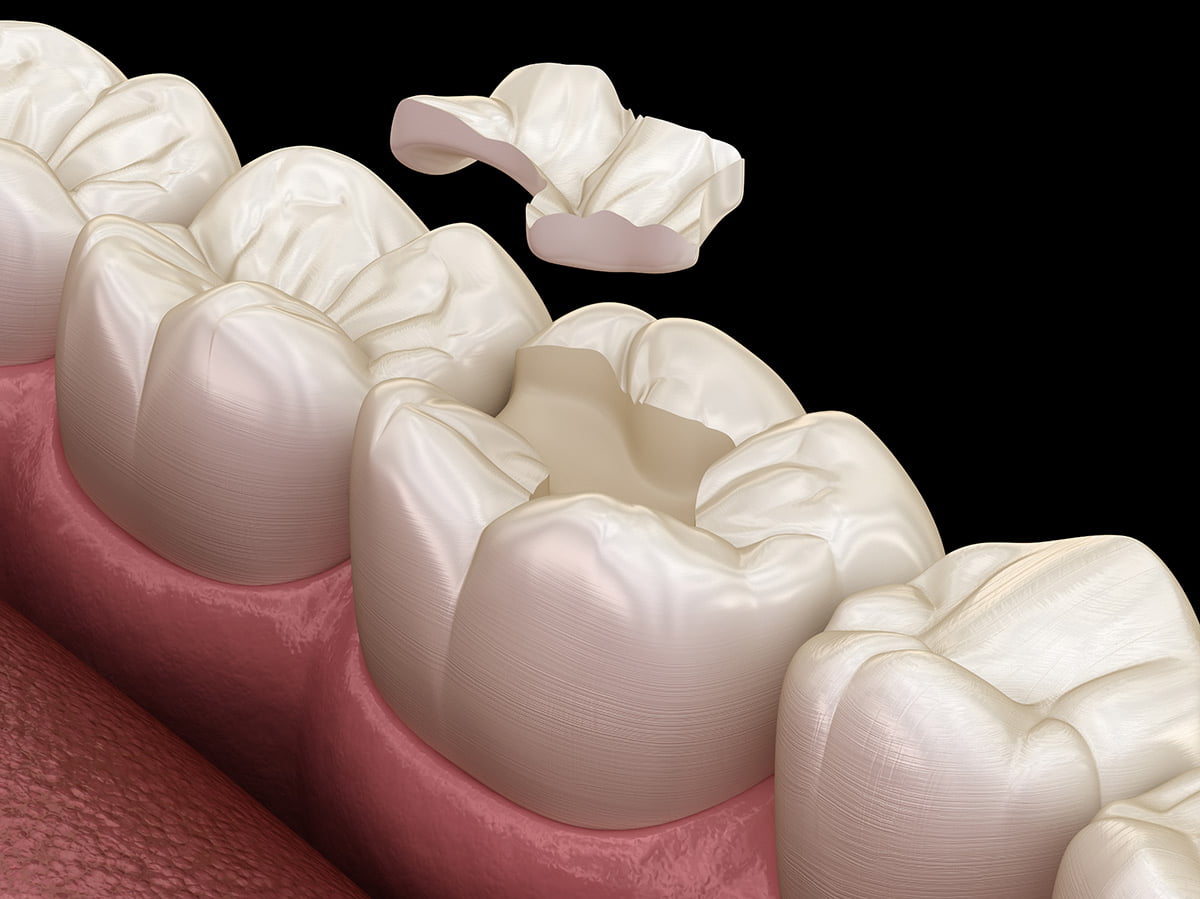
The process for creating and placing a partial crown begins with extensive dental preparations. Like a full dental crown, the dentist or prosthodontist executing the procedure will need to eradicate any traces of infection.
This is followed by the process of grinding down dental surfaces that the restoration will mechanically attach to. This is done to ensure that there is adequate surface space for the partial crown to adhere to.
Unlike direct restorations that are executed entirely within the confines of a dental clinic, partial crowns are often fabricated off-site. The process continues with a dental impression that records the existing conditions in a patient’s mouth. Then, this data is transmitted to a dental lab, where it is used to fabricate a precise partial crown that will fit exact specifications.
While the partial crown is being prepared off-site, a temporary inlay or onlay is often put in place. Then, when the final partial crown is made, the patient will return to the dental clinic to have the temporary crown removed and replaced with the final tooth restoration.
Why should I get a dental onlay or partial crown?
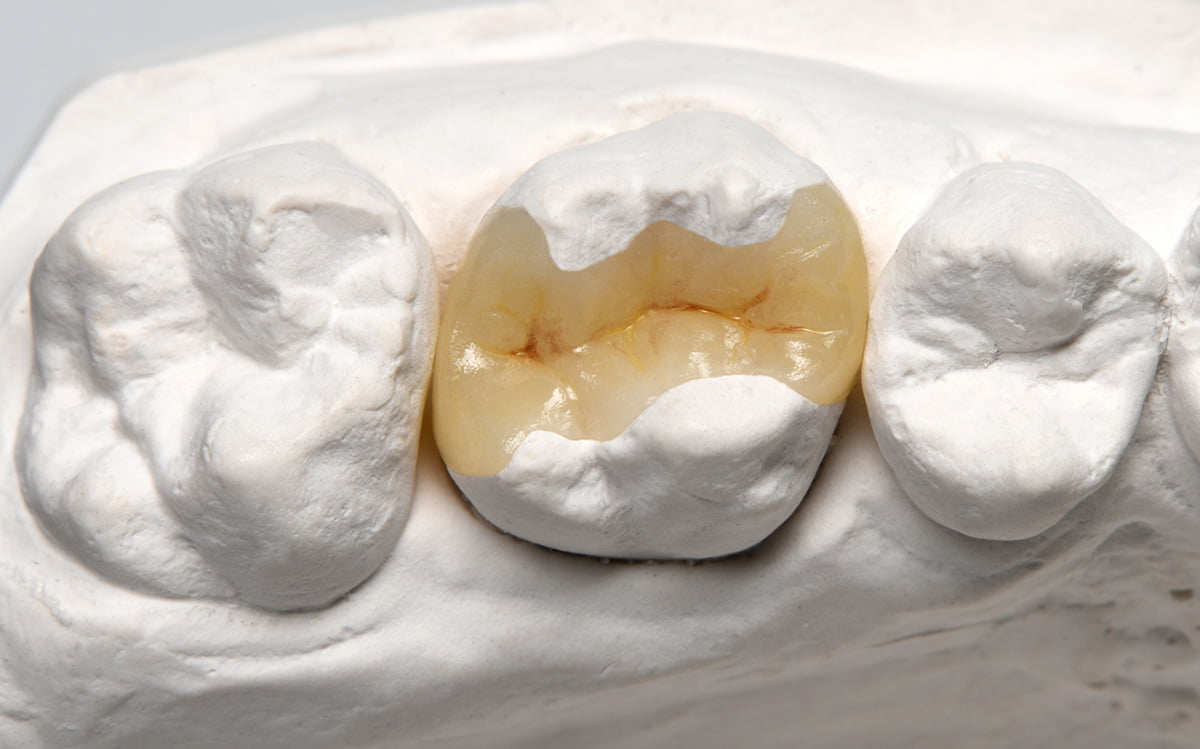
Dental onlays, sometimes called “partial crowns” or “indirect fillings,” and cover one or more of the cusps on the biting surface of a tooth to treat cavities, cracks, or broken teeth. Dental Onlays are a good option when the tooth is too damaged to support a dental filling but is not damaged enough to require a full crown.
Natural teeth look, work, and feel much better than artificial ones. Partial dental crowns provide patients with the ability to salvage and retain as much of their natural teeth as possible while still providing reinforcement where it matters.
Full dental crowns require the removal of a significant amount of dental material to accommodate a full crown. However, there are many situations in which a full crown merely is unwarranted. For example, a failed filling can be more economically and expeditiously solved with a partial crown inlay. Likewise, you can address a minor fracture, chip, or the loss of a dental cusp using a partial crown onlay.
You can sufficiently repair more extensive tooth damage with more extensive crowns such as a ¾ crown.
Are partial crowns right for you?
1. Can my tooth be salvaged?
An unsalvageable tooth that requires a tooth extraction would not benefit from a partial crown.
2. Do I need a root canal?
Chances are, if you have received a root canal, you will require a full crown, NOT a partial crown restoration, to ensure that the tooth does not suffer a fracture or breakage.
3. How extensive is my dental damage?
If the damage is too extensive but the tooth is salvageable, a dentist will likely recommend a full dental crown to ensure stability. In this case, a partial crown would be inadvisable.
4. Do I have failing fillings?
If you have an unusually large filling or a filling that is repeatedly failing, it might be a good idea to get a dental inlay or onlay.
5. Do I have unseemly cosmetic damage?
One of the best ways to repair your tooth and restore its aesthetic qualities is to invest in partial dental crowns such as inlays and onlays. Unlike direct restorations, such as dental fillings, partial crowns can be fabricated from any material, including beautiful and resilient porcelain. As a result, inlays and onlays can be made to look almost like natural teeth.
FREE All On 4
Dental Implant Assessment
Start your smile transformation today. Get our FREE personalized All On 4 Dental Implant Assessment & Guide. Just click the Start Now button below to get your FREE assessment. There is no obligation to buy but we promise the results are life-changing.
Choosing The Right Dentist or Prosthodontist
Why Quality Matters
“My final upper All-On-4 arch (even after the surgeon gave me an All-On-6) is awful! Definitely not worth the $30,500 in cash I paid up front. I have 12 ‘teeth’ which takes up only the front half of my mouth. I don’t have any molars, just an inch of pink gum material in the back. My bite is off and chewing food is awful! They’ve changed the shape of my jaw and now my mouth looks sunken because of the lack of molars which I had at my first visit.”
– Source: pissedconsumer.com
“I also had a single implant on my bottom jaw that I never received a temporary for. I expected the look and function of actual teeth. Dr.”
“Kim told me the final would look like my real teeth with veneers. OMG so far from the truth!”
Not All Cosmetic Dentistry Specialists Are Created Equal
Unfortunately, this is not a rare circumstance.
We see patients on a consistent basis at Willow Pass Dental Care who have had less than spectacular results, many coming from well-known dental chains or “professionals.”
When it comes to your mouth and your health, you should not take chances. The following are steps to ensure you are dealing with a professional who has the experience and knows what he or she is doing.
Following are 9 steps I recommend for choosing the right cosmetic dentistry specialist:
1. Does the Prosthodontist have the knowledge, skills and experience with cosmetic dentistry?
One of the easiest ways to determine if a prosthodontist is right for you is to do a simple check of their professional credentials.
Do the prosthodontists have the proper credentials, designations, certifications, awards, accreditations, and up-to-date training to show that they are the best at giving you the care you deserve?
2. Does the Prosthodontist and office have a good reputation?
I recommend you do a Google search and see what people are saying. Check ratings and reviews. Look at sites such as Pissed Consumer, DemandForce, Yelp, Facebook, and of course Google.
Sure, you can always find a critical or bad review from time to time. It’s when you find a lot of them that you need to take notice.
3. Meet the prosthodontist and team of specialists.
It is hard to fathom but some patients never meet the team. I recommend you take the time to meet the team prior to committing to a dental office or prosthodontist. Make sure you are comfortable and that you’ve done your research about the office as well as the doctor and the treatment procedure.
4. Discuss with the prosthodontist specific case studies or success stories you read or viewed online.
Ask which case study best resembles your situation and what are the challenges the dentist expects. If there are challenges that are expected have the prosthodontist explain the treatment strategy for your dental crown(s) and what the risks are.
5. Ask for a tour of the office.
Know where the dental crown procedure will take place and what it looks like.
Observe the dental equipment in the room. Is it clean and comfortable?
Are the facilities updated or outdated?
Ask if the equipment used is the latest dental in dental technology. If so, they should have equipment such as a 3D scanner and at least one CAD/CAM machine and milling unit for designing your crowns or inlays.
This is vital to know and can save you money and lots of time.
6. Cosmetic dentistry pricing should be transparent
You should not have to experience any hard sell. The pricing for dental crowns should be easy to compute based on these factors.
If you find it hard to determine what quality you are paying for and what your price includes, you should leave.
7. Local vs. Dental Chains
I believe being locally owned and operated like Willow Pass Dental Care brings us much closer to our patients. We are involved and part of the community.
This also results in a higher retention of patients versus dental chains who tend to focus on volume rather than providing ongoing dental care. Many dental chains offering cosmetic dentistry are less skilled and experienced and assemble a dental team based on the cheapest price rather than providing the best in talent, experience, and skill.
When it comes to your smile, including your mouth and teeth, it is best to invest in a doctor with the experience, knowledge, and skills to produce truly successful results.
FREE All On 4 Dental Implant Assessment
Dental Implant Assessment
Start your smile transformation today. Get our FREE personalized All On 4 Dental Implant Assessment & Guide. Just click the Start Now button below to get your FREE assessment. There is no obligation to buy, but we promise the results are life-changing.
 Written by Mirza R.
Written by Mirza R.